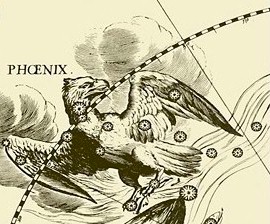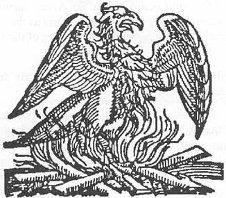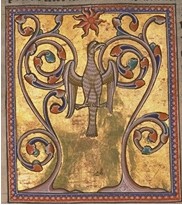Constellations of Words
Explore the etymology and symbolism of the constellations
the Phoenix

Hevelius,Firmamentum, 1690
Contents:
1. Clues to the meaning of this celestial feature
2. The fixed stars in this constellation
3. History_of_the_constellation
Clues to the meaning of this celestial feature
For the legends of the Phoenix click on these pages; Theoi Project and Wikipedia. Also the entry for the Phoenix in The Aberdeen Bestiary
The Phoenix is often referred to as the firebird, and is the constructor of a funeral pyre
“The phoenix is a bird of Arabia, so called because it possesses a scarlet (phoeniceus = purple) color, or because it is singular and unique in the entire world, for the Arabs say phoenix for ‘singular.’ This bird lives more than five hundred years, and when it sees that it has grown old it constructs a funeral pire for itself of aromatic twigs it has collected, and, turned to the rays of the sun, with a beating of its wings it deliberately kindles a fire for itself, and thus it rises again from its own ashes” [The Etymologies of Isidore of Seville, 7th century AD, p.265.]

Johann Bode, Uranoographia, 1801
“After Phoenix, the brother of Cadmus, moved from Egyptian Thebes to Syria, he reigned at Sidon and named those people Phoenicians and the province Phoenicia after his own name” [The Etymologies of Isidore of Seville, 7th century AD, p.194.]
 “The phoenix built its nest on top of the phoenix date-palm. It came from Arabia; i.e. Araba/Syria – Phoenicia, present-day Syria and Lebanon. As well as ‘phoenix‘ the word denoted ‘Phoenician‘ and the word ‘purple‘. The Phoenicians traveled to the edges of the known world at the time and introduced their alphabet, based on symbols for sounds – phonetics – rather than cuneiform or hieroglyphic representations, to the Greeks and other early peoples.” [AHD].
“The phoenix built its nest on top of the phoenix date-palm. It came from Arabia; i.e. Araba/Syria – Phoenicia, present-day Syria and Lebanon. As well as ‘phoenix‘ the word denoted ‘Phoenician‘ and the word ‘purple‘. The Phoenicians traveled to the edges of the known world at the time and introduced their alphabet, based on symbols for sounds – phonetics – rather than cuneiform or hieroglyphic representations, to the Greeks and other early peoples.” [AHD].
The fifth century Greek Horapollo said that the phoenix signifies in hieroglyphs a man returning from a prolonged residence abroad. [The Odyssey re-formed, Frederick Ahl]
The figurative sense is of “that which rises from the ashes of what was destroyed” []. The city of Phoenix in Arizona was so named because it was reborn out of the ancient remains of the Hohokam Indian people, who once populated the land around 300 B.C – 1450 A.D. Western Apaches referred to the area as ‘Fiinigis‘ [].
Klein (Comprehensive Etymological Dictionary) says that phoenix is related to; “Greek phoinos ‘bloodred’, phonos (for *ghonos), ‘murder’, phonos (for *ghenyein), ‘to strike’ and cognate with Latin de-fendere …” Latin defendere comes from the Indo-European root *gwhen ‘To strike, kill’. Derivatives: bane (a cause of harm, ruin, or death), baneful, gun, defend, defense, fence, fend, offend, offense. [Pokorny 2. gwhen-(e)- 491, bhen- 126. Watkins
The word Punic is from Greek Phoinix, Phoenician, and relates to ancient city of Carthage which was founded by the Phoenician Dido [, p.98]. Dido fell in love with Aeneas (might be Indus) and committed suicide in grief after he abandoned her. Like the phoenix, Dido, whose epithet was ‘Phoenissa‘ constructed a funeral pile and threw herself on the flames.
From ancient Greek times the phoenix has been associated with the bennu (benu) bird of Egyptian mythology. It is said that this identification is supported by the fact that in Greek the word Phoenix can mean ‘palm tree’, and so does benu have the alternative meaning of ‘palm tree’ in Egyptian. The ancient Egyptian benu is thought to be really the Purple Heron (Ardea purpurea) [, p.125]. The planet Venus was called the ‘star of the ship of the Bennu-Ausar’ (Osiris), mentioned as the Morning Star in this invocation to the sacred sun bird. “I am the Bennu, the soul of Ra, and the guide of the gods in the Tuat; let it be so done unto me that I may enter in like a hawk, and that I may come forth like Bennu, the Morning Star” [].
© Anne Wright 2008.
| Fixed stars in Phoenix | |||||||
| Star | 1900 | 2000 | R A | Decl 1950 | Lat | Mag | Sp |
| epsilon | 08PIS16 | 09PIS39 | 001 43 11 | -46 01 24 | -41 57 05 | 3.94 | G7 |
| zeta | 10PIS59 | 12PIS22 | 016 34 18 | -55 30 46 | -55 07 49 | 4.13 | B7 |
| kappa | 13PIS08 | 14PIS31 | 005 56 13 | -43 57 26 | -41 47 34 | 3.90 | A3 |
| Ankaa alpha | 14PIS05 | 15PIS30 | 005 57 15 | -42 34 39 | -40 37 33 | 2.44 | G5 |
| beta | 19PIS03 | 20PIS26 | 015 57 50 | -46 59 10 | -48 11 58 | 3.35 | G4 |
History of the constellation
from Star Names 1889, Richard H. Allen
Phoenix, the French Phenix, the German Phonix, and the Italian Fenice, is one of Bayer’s new figures, between Eridanus and Grus, south of Fornax and Sculptor, — its alpha, kappa, mu, beta, nu, and gamma in a line curving toward the south like that of a primitive Boat, by which figure, as Al Zaurak, the Arabs knew them. Al Sufi cited another name, — Al Ri’al, the Young Ostriches, — which Hyde wrongly read Al Zibal, perhaps a synonymous title; and Kazwini used Al Sufi’s term in describing some stars of Al Nahr, the River, in which our Phoenix was then included by Arabian astronomers.
{Page 336} Others changed the figure to that of a Griffin, or Eagle, so that the introduction of a Phoenix into modern astronomy was, in a measure, by adoption rather than by invention.
But, whether Bayer knew it or not, his title is an appropriate one, for with various early nations — at all events, in China, Egypt, India, and Persia — this bird has been “an astronomical symbol of cyclic period,” some versions of the well-known fable making its life coincident with the Great Year of the ancients beginning at noon of the day when the sun entered among the stars of Aries; and, in Egypt, with the Sothic Period when the sun and Sirius rose together on the 20th of July. Thompson further writes of this:
“A new Phoenix-period is said to have commenced A.D. 139, in the reign of Antoninus Pius; and a recrudescence of astronomical symbolism associated therewith is manifested on the coins of that Emperor.”
Coincidently, Ptolemy adopted as the epoch of his catalogue the year 138, the first of Antoninus. With the Egyptians, who knew this bird as Bennu and showed it on their coins, it was an emblem of immortality; indeed it generally has been such in pagan as well as in Christian times.
In China the constellation was HoNeaou, the Fire Bird, showing its derivation there from the Jesuits.
Julius Schiller combined it with Grus in his Aaron the High Priest. Gould catalogues 139 naked-eye stars here, from 2.4 to 7.
Star Names: Their Lore and Meaning, Richard H. Allen, 1889.]
